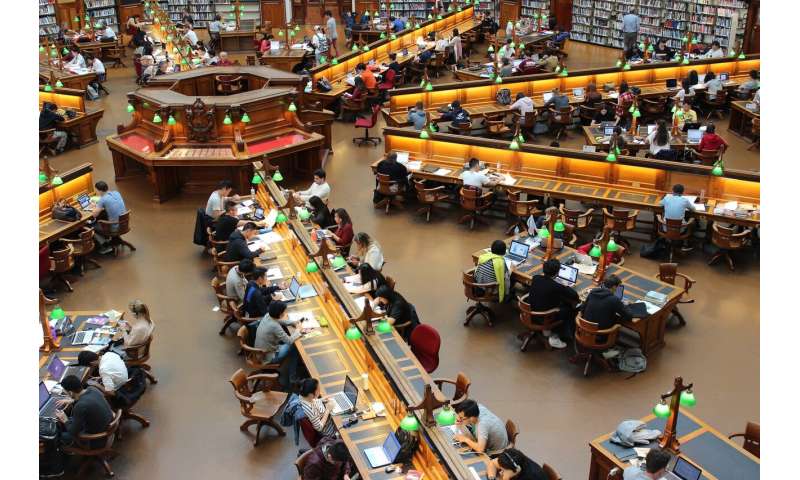By Gail McCormick
Penn State University News, May 18, 2020
“The STEM pipeline has traditionally lost huge amounts of talent from under-resourced and underrepresented groups, so to address their needs we have to be asking the right questions.”
With the sudden closure of campuses across the nation to curb the spread of COVID-19 , undergraduate students relocated to a wide variety of living situations, many of which present challenges to learning.
Researchers from Penn State and the University of Connecticut have received a one-year $199,156 Rapid Response Research (RAPID) grant from the National Science Foundation to map the complex landscape of challenges faced by students, particularly from underrepresented groups.
These insights could help universities and instructors support students with the greatest needs, improve distance learning, and provide an evidence-base for interventions to maintain the current cohort of students in the pipeline leading to STEM careers.
“The impacts of this unexpected transition to distance learning are not equal among students,” said Nathanial Brown, professor of mathematics and leader of the research team. “As universities closed, many students entered resource-limited or stressful domestic situations that are not conducive to learning.”

According to the research team, students with certain characteristics may be disproportionally impacted. For example, students with low socioeconomic status may have inadequate housing options, limited access to high-speed internet, and be pressured to work. First generation students of certain racial or ethnic backgrounds are more likely to return to multigenerational homes, where maintaining boundaries may be a challenge. And women may experience greater domestic workloads, including child and eldercare responsibilities, upon returning home.
“These types of situations could exacerbate challenges to academic performance caused by disruption of learning due to the pandemic,” said Brown. “To address the barriers to learning that these students face, which is particularly important for retaining much-needed diversity within the STEM pipeline, we first need to identify the vast variety of barriers.”
The research team plans to document student experiences during the transition away from campus, the challenges they experience, how these challenges affect academic performance, and factors that facilitated success or failure among under-resourced and underrepresented students. Importantly, they will investigate how intersectionality—the interplay of low socioeconomic status, underrepresented race or ethnicity, and female gender—influences the variety and magnitude of COVID-19-related barriers to STEM education.
To explore the many factors influencing educational success, the research team will use a framework called the Socioecological Model. This model incorporates factors at five different levels, including the individual (e.g. stress, motivation), interpersonal relationships (e.g. family environment, social support), organizational (e.g. school response), and community (e.g. neighborhood socioeconomic status) as well as public policy in the area (e.g. shelter in place orders).
“Most research of this type focuses on one or two layers, but we have every reason to believe all layers are important,” said Brown. “For example, the severity of the pandemic on a student’s local environment could have a big impact on their psychological stress. If you’re in a rural community that only has 100 cases, that’s very different from living in a crowded city with hundreds of people dying every day.”
The team will first conduct focus groups with undergraduate STEM students from colleges and universities across the nation. The aim of this phase is to hear directly from a diverse population of students about the challenges they faced as a result of the pandemic. In the second phase, based on these responses, the team will create and administer a survey to 1,000 STEM students from across the country. This survey will measure the prevalence and impacts of different challenges faced by different demographics of students.
“The goal of the first phase is to make sure we are asking the right questions in the second phase,” said Brown. “The fact is that as a white man living in Centre County, I don’t know the right questions to ask of Hispanic students in Los Angeles. The STEM pipeline has traditionally lost huge amounts of talent from under-resourced and underrepresented groups, so to address their needs we have to be asking the right questions.”
The research team will share their results with universities and instructors, who could then discuss how to address these challenges and implement appropriate interventions to support students impacted by the current pandemic. This work may also inform how universities and instructors design online courses in the future.
“By understanding what makes a positive home learning environment, universities can help students make choices about whether online learning is right for them,” said Brown “I also hope that documenting the many ways that students struggle will help continue to raise empathy among my colleagues. Especially in this challenging time, we must all ensure that we are educating everybody that shows up in our classes, not just the majority.”
In addition to Brown, the research team includes Sherry Pagoto and Molly Waring at the University of Connecticut.
This article previously posted on phys.org. Visit https://phys.org/news/2020-05-covid-pandemic-affects-college-students.html












